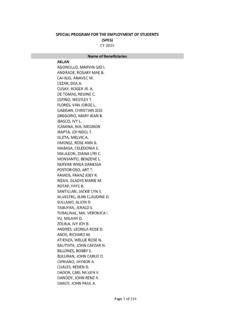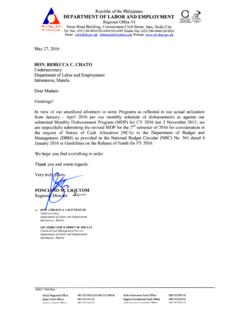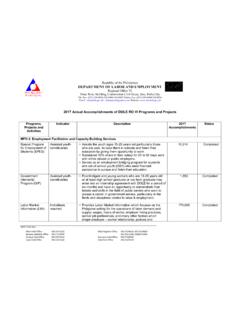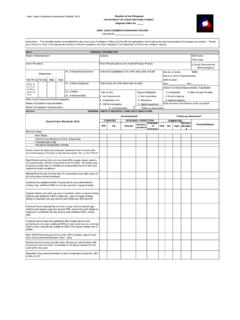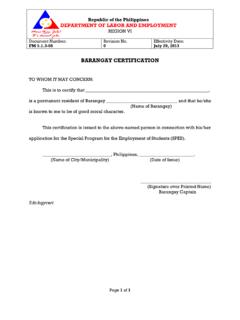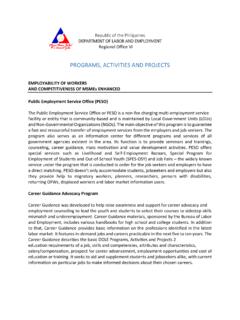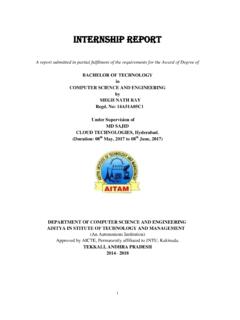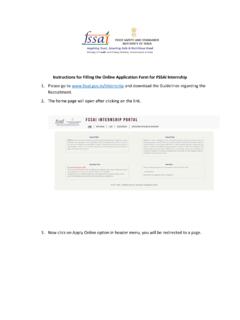Transcription of The On-the-Job Training Manual
1 The On-the-Job Training Manual The On-the-Job Training Manual The On-the-Job Training Manual Table of Contents THE On-the-Job Training Manual . RATIONALE 3. WHAT IS On-the-Job Training ? 4. OJT Manual GENERAL OBJECTIVES 4. ADMISSION REQUIREMENTS 5. ROLES AND RESPONSIBILITIES OF INVOLVED PARTIES. STUDENT/TRAINEE 7. PARENTS/GUARDIAN/SPOUSE 7. HIGHER EDUCATION INSTITUTION (HEI)/. TECHNICAL VOCATIONAL INSTITUTIONS 8. FACULTY PRACTICUM COORDINATOR 9. PARTNER OJT INSTITUTION 10. ON-SITE SUPERVISOR 11. MONITORING AND EVALUATION OF OJT. WEEKLY JOURNAL/REPORT 13. SUPERVISOR EVALUATION 13. POST-MORTEM EVALUATION 14. APPENDIX. MEMORANDUM OF AGREEMENT 16. SAMPLE EVALUATION FORMS 17. Page 2. The On-the-Job Training Manual RATIONALE. Academic institutions are faced with challenges particularly on the skills they produced which do not match the needs of the industry.
2 A significant number of graduates today are unable to fill the job openings due to job-skill mismatch. A. great number of these skills found lacking by companies are taught in the academe that is, technical, human resource and conceptual skills. In addition to that, these same skills can also be reinforced through On-the-Job Training programs. On-the-Job Training (OJT) programs are course requirements providing an opportunity to apply the theories, principles and ideas learned in the academe under supervision. These Training programs expose the students to work realities which will ideally hone their skills and prepare them once they get out of the university or college. A study conducted by the People Management Association of the Philippines (PMAP) in 2006, emphasized the importance of an effective on-the- job Training program.
3 Achievement of the OJT program objectives ensures the possibility of good performer graduates. The opposite will most likely produce poor performer graduates thus, promoting job-skill mismatch. Hence, On-the-Job Training programs, vital as it is, should be dynamic and skill centered for the students to effectively grasp the practical learning in the workplace. Relative to this, a great number of universities and colleges utilize national government agencies and private institutions as venues for their On-the-Job Training programs. Because of the importance of On-the-Job Training programs, there is a need to ensure that students undertaking their Training in these private and public institutions are given skill-specific tasks and mentoring. Despite this knowledge, there is an apparent lack of clear guidelines between the academe, the government and participating industry partners in regards to specific learning objectives and Training needs of students endorsed to them (NGAs) for Training .
4 Moreover, malpractices in the government where students are tasked to do menial, unstructured tasks downgrade the value and learning output of OJT programs. As a result, companies and employment agencies find the new entrants lacking of the necessary skills during the hiring process. This is true as well in the case of private corporations. In view thereof, it's vital that strategic agreements between the academe and the government as well as the academe and private companies should be undertaken, focusing on the creation of clear objectives, clear expectations, establish methods of learning verification and effective monitoring Page 3. The On-the-Job Training Manual and implementation specific to the On-the-Job Training programs. WHAT IS On-the-Job Training ?
5 A Training program for students designed to immerse them in a work environment relevant to their courses in the attempts to learn productivity in, knowledge on, and respect for the workplace. As discussed, On-the-Job Training programs are course requirements providing an opportunity to not only apply the theories, principles and ideas learned in the academe but also enhance the technical knowledge, skills and attitudes of students towards work necessary for satisfactory job performance. On-the-Job Training programs also serve as a venue where students earn experience in career positions relevant to their choice of academic degrees as well as open up other future career choices towards gainful employment. OJT Manual GENERAL OBJECTIVES. Provide students with actual workplace experience, exposure to various management styles, industrial and procedures of various occupations in relation to their respective fields of learning.
6 Provide standards and guidelines for conducting OJTs such as amount of workload, number of hours, learning objectives, monitoring scheme and sanctions;. Clearly establish the roles and responsibilities of involved parties and provide for protocols regarding different situations that may arise during the OJT;. Promote the OJT program through standardized procedures that are uniform, manageable, and practical so that more institutions will participate through;. Promote and establish strategic agreements between the academe and the government as well as the academe and private companies focusing on the creation of clear objectives, clear expectations, establish methods of learning verification and effective monitoring and implementation specific to the On-the-Job Training programs.
7 Page 4. The On-the-Job Training Manual ADMISSION REQUIREMENTS. There should be a Memorandum of Agreement and Guidelines specifically outlining the role and responsibilities of all concerned parties, Training plan, learning objectives and method of evaluation between the school and the partner institution/company/office. The student/trainee should submit a letter of indorsement from the school's authorized personnel confirming that s/he is indeed qualified to complete the On-the-Job Training program. The student/trainee should submit to the partner institution/company/office a copy of the waiver of consent duly signed by his/her parent/guardian/. spouse, pledge of good conduct, bio-data and course syllabus. Page 5. The On-the-Job Training Manual Page 6. The On-the-Job Training Manual STUDENT/TRAINEE.
8 An admitted student/trainee shall abide by the rules and regulations set forth by the institution/company/office where s/he is undergoing On-the-Job Training . The student/trainee should always observe discipline and right conduct. The student/trainee should wear the appropriate dress code. S/he should not engage in gambling, illicit activities, drinking intoxicating beverages and related activities while at work or within the institution/. company/office premises. The student/trainee is expected to submit reports and requirements on time. The student/trainee should observe punctuality and attendance in reporting to his/her assigned Training area. S/he should accomplish the attendance recording sheet noted by the Training supervisor. PARENTS/GUARDIAN/SPOUSE.
9 The parents/guardian/spouse shall co-sign the Training contract to manifest approval or consent to the On-the-Job Training of their child/spouse. The parents/guardian/spouse shall also issue a waiver of consent. Page 7. The On-the-Job Training Manual HIGHER EDUCATION INSTITUTION (HEI)/TECHNICAL VOCATIONAL. INSTITUTION (TVI). The school/HEI/TVI shall formulate the On-the-Job Training policies and guidelines on the selection, placement, monitoring and assessment of student/trainees. The school/HEI/TVI shall assign a regular faculty member, tenured and academically qualified as Faculty Practicum Coordinator responsible for all aspects of the student internship programs including program implementation, monitoring and evaluation. The school/HEI/TVI shall select the partner institution/company/office and ensure acceptability of Training design and venue in order to protect the student/trainee's interest.
10 The school/HEI/TVI shall develop in collaboration with the duly selected partner institution/company/office a Training Plan, which will form part of Training contract, for the student trainee/ intern specifying goals and objectives, knowledge, skills and competencies that the student trainee should acquire in each Training area, assignments and schedule of activities, among others. The school/HEI/TVI shall also monitor and evaluate performance of student/. trainee jointly with the partner institution/company/office based on the agreed Training plan. The school/HEI/TVI shall monitor the student/trainee and immediately attend to his/her complaints by coordinating with the partner institution/company/. office, CHED and other concerned government authorities if necessary.
